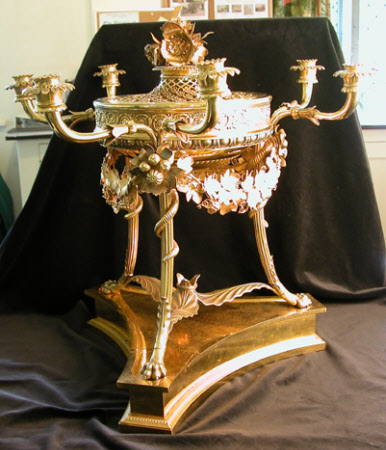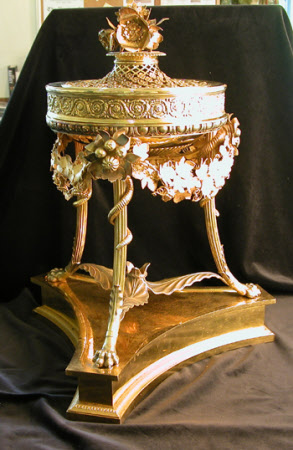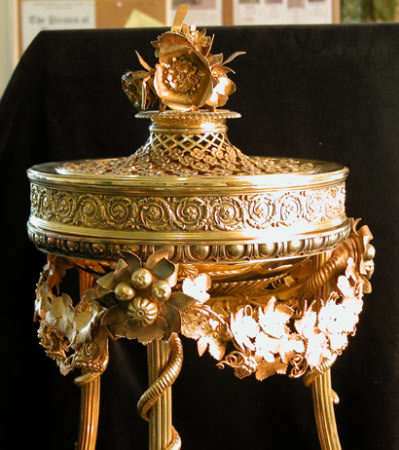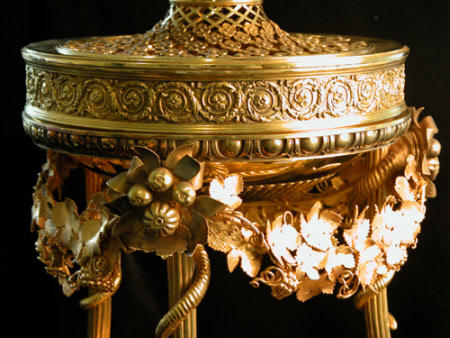Centrepiece
Benjamin Smith II and James Smith III
Category
Silver
Date
1809 - 1810
Materials
Silver-gilt, sterling, ormolu, wood, baize
Measurements
57.2 x 59.5 x 52.7 cm; 10053 g (Weight)
Place of origin
London
Order this imageCollection
Anglesey Abbey, Cambridgeshire
NT 516440
Summary
A monumental centrepiece comprising a six-light candelabrum with central perfume burner, silver-gilt (sterling), ormolu, wood, and baize, mark of Benjamin and James Smith, London, 1809/10. The triangular ormolu plinth with incurved sides and canted corners is stepped and applied with a border of stiff leaves at the base and a narrow border of leaves at the cornice. The top is dished to accommodate the three feet of the stand’s base. The underside is filled with wood covered with green baize. The silver-gilt base has three cast splayed fluted legs which terminate in leaf-capped lion’s paw feet. Protruding from the back of the feet are three large cast leaves, which curl to meet in the stand’s centre, where they are linked by a narrow wreath of laurel leaves. Cornucopia spiral up the top half of the legs; each terminating in a circular disk, at the top of which is a numbered socket for a candelabra branch. Fixed to the front of the disk with two pairs of screws are two semi-circular numbered disks which support the frosted festoons of vine leaves and grapes. Screwed to the disks and forming the head of each cornucopia is a numbered circle of chased and curled leaves applied with three cast apples and one detachable melon. A cast circular silver-gilt band with egg and dart border sits on the top of the legs to support the removeable perfume burner. The burner’s large, almost hemi-spherical, bowl is raised and embossed in the centre with a patera surrounded by a wide sunburst of fluting. At the top of the sides, between two applied moulded borders, is a finely cast and chased frieze of scrolling foliage and quatrefoils. The pull-off circular cover is raised and applied with a deep flange. A wide flat border and applied narrow moulded border surround the centre of the cover, which is pierced with a pattern of lattices reducing in size as they rise towards the open centre, where the unpierced silver rises up and out to an applied cast egg and dart rim. Each cross in the latticework is decorated with a cast quatrefoil of diminishing size, secured by a rivet. The centre of the perfume burner’s cover supports a removeable circular box. The box’s flat top is pierced with one circular and four oval holes, which hold sprays of flowers secured to the base with screws. The flowers and their leaves vary in form, and are raised from sheet metal with wire stems. Each of the three detachable branches bifurcates into a pair of cornucopia-shaped branches applied with a trumpet-shaped spray of four leaves and eight petals. They terminate in a daffodil-like sconce with matt petals. The plugs are stamped with one to three dots to correspond to the engraved Arabic numbers on the sockets of the stand. The detachable nozzles are seamed and have an applied border of beads and an everted scalloped rim. Each sconce and nozzle has locating notches, numbered from one to six, cut into its edge. Heraldry: None Hallmarks: Fully hallmarked on the side of the perfume burner and on the ring of the stand which supports the burner: ‘BS’ over ‘IS’ (Benjamin Smith & James Smith*), lion passant (sterling), leopard’s head (London), ‘O’ (1809/10), and monarch’s head (duty mark); part marked on the branches and the nozzles: ‘BS’ over ‘IS’, monarch’s head, lion passant, and ‘O’; on the flange of the perfume burner’s cover: ‘BS’ over ‘IS’, lion passant, and ‘O’; on the base of the sconce and on the centre of each cornucopia’s leaves: ‘BS’ over ‘IS’, lion passant and monarch’s head; and on each detachable melon: lion passant *Arthur Grimwade: London Goldsmiths 1697-1837, London, 1990, p 28, no 238 Scratch weight: None
Full description
Early candelabra usually comprise a traditional candlestick supporting two, three or four branches; the branches meet in the centre at a socle, which fits into the candlestick’s sconce. It was not until the late 18th and early 19th century that the Prince of Wales taste for grandiose silver encouraged the production of taller and more imposing designs. Keen to supply the demand, the great retailers of the day produced ever more complex candelabra often combining statuary with multi-layered lights, such as the tall centrepiece commissioned by the 6th Duke of Devonshire from Rundell, Bridge & Rundell, and marked for Paul Storr in 1813/4. [1] These centrepieces were as important for display as for providing light. Anglesey Abbey’s candelabrum is an early example of a multi-functional centrepiece combining its six-lights with a perfume burner. Benjamin Smith and his partner Digby Scott produced silver exclusively for Rundell’s between 1802 and 1807, but by 1809 Benjamin Smith was in partnership with his brother James, supplying London’s retail trade. The Abbey’s centrepiece does not bear a retailer’s mark, but may have been produced for Rundells or for Green, Ward & Green, who stamped their name on a similar one made by Benjamin Smith alone in 1813/4. [2] [1] Christopher Hartop: Art in Industry: The Silver of Paul Storr, Cambridge, 2015, p 46 [2] Vanessa Brett: The Sotheby’s Directory of Silver, London and New York, 1986, p 247, no 1113 Jane Ewart, 2025
Provenance
(Urban) Huttleston Rogers Broughton, 1st Baron Fairhaven (1896-1966) bequeathed by Lord Fairhaven to the National Trust along with the house and the rest of the contents National Trust
Credit line
Anglesey Abbey, the Fairhaven Collection (National Trust)
Makers and roles
Benjamin Smith II and James Smith III, goldsmith



